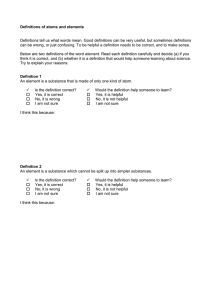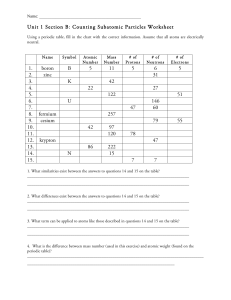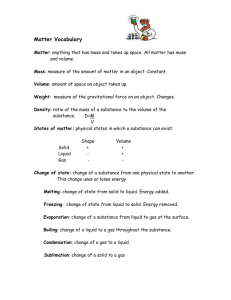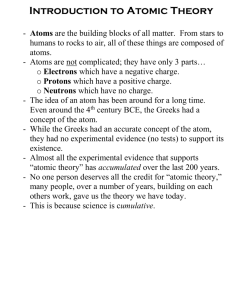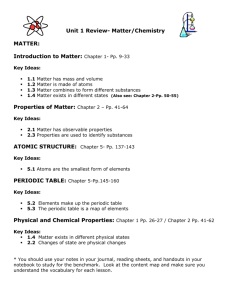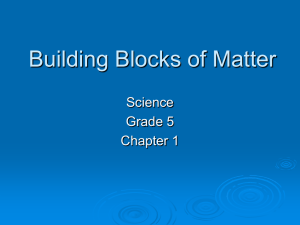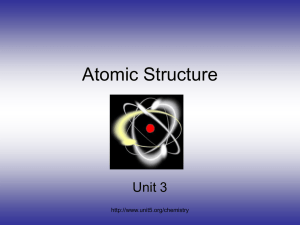Lakeview School 808 Bacon Street Durham, NC
advertisement
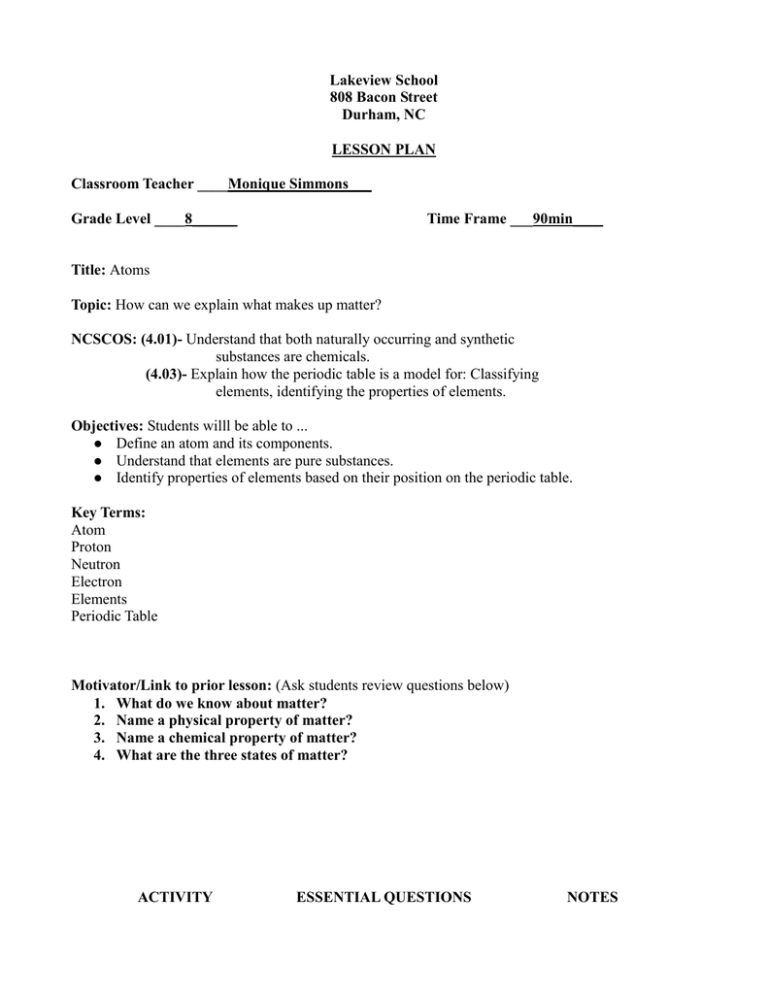
Lakeview School 808 Bacon Street Durham, NC LESSON PLAN Classroom Teacher ____Monique Simmons___ Grade Level ____8______ Time Frame ___90min____ Title: Atoms Topic: How can we explain what makes up matter? NCSCOS: (4.01)- Understand that both naturally occurring and synthetic substances are chemicals. (4.03)- Explain how the periodic table is a model for: Classifying elements, identifying the properties of elements. Objectives: Students willl be able to ... Define an atom and its components. Understand that elements are pure substances. Identify properties of elements based on their position on the periodic table. Key Terms: Atom Proton Neutron Electron Elements Periodic Table Motivator/Link to prior lesson: (Ask students review questions below) 1. What do we know about matter? 2. Name a physical property of matter? 3. Name a chemical property of matter? 4. What are the three states of matter? ACTIVITY ESSENTIAL QUESTIONS NOTES ATOM WORLD (Alice Animation) atomworld.a2w 1. What is an atom? 20 min 1. All matter is made up of atoms, which are far too small to see even with a microscope. Atoms are the smallest unit of matter. 2. They are made up of 2. How can we describe the parts subatomic particles called of an atom? protons, neutrons, and electrons. 3. How are atoms and elements related? Periodic Table Internet Activity (www.chemkids.com) 1. What does the periodic table tell us about elements? 40min Adopt an Element activity 3. Elements are substances that are made up of only one kind of atom. Atoms of any element are alike but different from atoms of other elements. Elements cannot be broken down into any other substance, thus they are called pure substances. 1. The periodic table is a model that helps classify and identify the properties of each element. It is like a map of the elements. Each element has its own unique chemical and physical properties. 2. How are elements positioned on the periodic table? 2. Elements are placed in categories or groups if they have similar properties; metals are an example of such a group. 1. What does an element atomic # represent? 1. Atomic# represents the number of electrons. 30min 2. What does the atomic mass Students make an advertisement represent? about their element. 3. How can you determine the number of neutrons in an element? 2. The atomic mass represents the number of protons and neutrons. 3. atomic mass minus atomic #. Based on the properties of an element, what group would they be in? Assessment: In a paragraph (6-8 sentences) using all the key terms, explain the substances that make up matter. Modifications: ESL/Non-readers – Draw storyboards to explain main concepts of lesson. Learning disabled Give extended time to complete lesson. Group discussion - provide discussion questions so students can verbalize understanding of lesson. BACKGROUND INFORMATION Everything in the environment is made up of chemicals, thus all forms of matter are made of chemicals. All matter is made up of atoms, which are far too small to see even with a microscope. Atoms are the smallest unit of matter. They are made up of subatomic particles called protons, neutrons, and electrons. Elements are substances that are made up of only one kind of atom. Atoms of any element are alike but different from atoms of other elements. Elements cannot be broken down into any other substance, thus they are called pure substances. About 100 different elements have been identified from which everything is made. All materials in the world are the result of different combinations of a relatively small number of elements. The periodic table is a model that helps classify and identify the properties of each element. It is like a map of the elements. Each element has its own unique chemical and physical properties. Elements are placed in categories or groups if they have similar properties; metals are an example of such a group. Metals are good conductors of electricity. Most of the known elements are metals. Nonmetals are poor conductors of electricity and have many different properties. Along the staircase borderline separating metals from nonmetals are the metalloids. They are neither good conductors or poor conductors of electricity.
